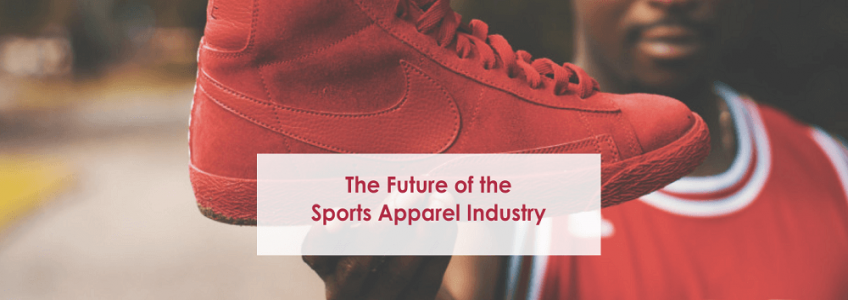The Future of the Sports Apparel Industry: "Navigating Sustainability, Cost Pressures, IP Issues, and Changing Consumer Trends"

Some common product types in the sports apparel industry include:
- Activewear: This category includes clothing specifically designed for physical activity, such as yoga pants, sports bras, and performance tops.
- Running shoes: Running shoes are designed to provide comfort, support, and stability for athletes who engage in running and other high-impact activities.
- Sports jerseys: Sports jerseys are designed to be worn by athletes during games and events and typically feature the logo and colors of a specific team or organization.
- Performance equipment: This category includes products designed to enhance an athlete's performance, such as heart rate monitors, GPS watches, and resistance bands.
- Accessories in the sports apparel industry include products like hydration packs, headbands, and arm sleeves.
1 . Prevailing Challenges within the Sports Apparel Industry
1. Competition:
- Performance Apparel: Nike, Under Armour, and Adidas compete in the performance apparel segment, offering products designed for specific sports and activities.
- Athleisure Wear: Lululemon, Athleta, and Fabletics compete in the athleisure wear segment, offering clothing that can be worn during and after physical activity.
- Running Shoes: Nike, Adidas, New Balance, and Puma compete in the running shoe segment, offering products designed to enhance performance and comfort for runners.
- Outdoor Apparel: Brands such as Patagonia, North Face, and Columbia compete in the outdoor apparel segment, offering products designed for outdoor activities such as hiking and camping.
- Fitness Equipment: Peloton, NordicTrack, and Bowflex compete in the fitness equipment segment, offering products designed to enhance the home workout experience.
2. Cost Pressure:
- Raw Material Prices: The price of raw materials used in sports apparel, such as textiles and synthetic materials, can be subject to fluctuations due to changes in supply and demand, as well as changes in energy and transportation costs. Brands must manage these fluctuations and seek ways to reduce their raw material costs to remain competitive.
- Labor Costs: The cost of labor can be a significant factor in the production of sports apparel, especially in regions where labor costs are high. Brands must manage their labor costs to produce high-quality products at a competitive price. This can involve a combination of strategies, including outsourcing production to countries with lower labor costs and investing in technology to improve productivity.
- Geography: The cost of production and transportation can vary greatly depending on geography. For example, the cost of production in Asia is generally lower than in North America or Europe. Brands must manage these differences in the cost to ensure that they produce products in the most cost-effective locations. They must also manage the additional costs associated with transportation and logistics to ensure that their products are delivered to consumers promptly and cost-effectively.
3. Changing Consumer Trends:
- Athleisure Wear: In recent years, the popularity of athleisure wear has skyrocketed, leading to the growth of brands such as Lululemon and Fabletics. Consumers seek comfortable and stylish clothing worn during and after physical activity.
- Sustainability: Consumers are increasingly seeking products that are environmentally friendly and sustainable. Brands such as Patagonia and Adidas have responded by incorporating sustainable practices into their products and supply chains, such as using recycled materials and reducing waste.
- Technology: Consumers demand products incorporating technology to enhance their performance and experience. Brands like Nike and Under Armour have responded by incorporating moisture-wicking fabrics, GPS tracking, and biometric sensors into their products.
- Personalization: Consumers seek products tailored to their individual needs and preferences. Brands such as Adidas and Nike have responded by offering customization options, such as the ability to choose different colors and designs, and using data and analytics to better understand consumer preferences.
- Health and Wellness: Consumers increasingly focus on health and wellness and seek products that support their fitness goals. Brands such as Lululemon and Under Armour have responded by offering products designed to enhance performance, recovery, and overall health.
4. Intellectual Property (IP):
- Trademark Infringement: In 2018, Adidas sued Forever 21 for selling shoes similar to their popular "Stan Smith" sneakers. Adidas claimed that Forever 21's shoes infringed on their trademark and diluted the Adidas brand.
- Patent Infringement: In 2020, Under Armour sued competitor Puma for allegedly infringing on its patent for a moisture-wicking fabric. Under Armour claimed that Puma's use of a similar fabric in their products constituted patent infringement.
- Copyright Infringement: In 2021, Nike sued many companies for selling counterfeit versions of their products. Nike claimed that the companies infringed on their copyrights by using Nike's distinctive logos and designs on counterfeit products.
5. Sustainability:
- Patagonia is a leading brand in the outdoor apparel industry and is known for its commitment to sustainability. The company uses recycled materials in its products, operates a closed-loop supply chain, and supports environmental activism through its "1% for the Planet" program.
- Adidas has made sustainability a priority, and the company has set a goal of becoming climate neutral by 2050. The company has launched several initiatives to reduce its environmental impact, including using recycled materials in its products and implementing more sustainable manufacturing processes. Adidas has launched products made from recycled ocean plastics and has set a goal to use only recycled polyester in all its products by 2024.
- H&M has made sustainability a key part of its business strategy and aims to become 100% circular and climate positive by 2030. The company has launched several initiatives to reduce its environmental impact, including implementing more sustainable manufacturing processes and using recycled materials in its products.
- The North Face is a leading outdoor apparel industry brand known for its commitment to sustainability. The company has set a goal of becoming carbon neutral by 2025 and has launched several initiatives to reduce its environmental impact, including the use of recycled materials in its products and the implementation of more sustainable manufacturing processes.
6. Globalization:
Brands must also deal with intellectual property and counterfeiting issues, as counterfeit products are increasingly prevalent in global markets. Brands must invest in measures to protect their intellectual property, such as trademarks and patents, and take steps to combat counterfeitings, such as working with law enforcement agencies and customs officials.
2 . Sports Apparel Market Size and Forecast
The global Sports Apparels market is projected to grow from USD 291.23 billion in 2022 to USD 469.3 billion in 2029. Asia-Pacific is the leading market for sports apparel, accounting for about 36% of the total, followed by Europe at 30% and North America at 19%. Nike, Adidas, Under Armour, Anta, and Puma are the leading sports apparel producers, with the top 3 accounting for about 7% of the market.
While global apparel retail industry had total revenues of USD 1,463.9 billion in 2021, representing a compound annual growth rate (CAGR) of 1.5% between 2017 and 2021.
Clothing, footwear, and accessories specialists account for the largest proportion of sales in the global apparel retail industry in 2021; sales through this channel generated USD 670.9 billion, equivalent to 45.8% of the industry's overall value.





